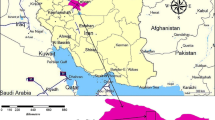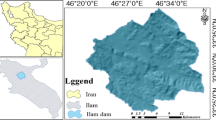Abstract
The present study comprises the application of various Fuzzy algebraic functions for assessment of landslide vulnerability in Rumtek-Samdung area of Sikkim, which is a Himalayan state in India. The thematic layers for probable causative factors for landslides were collected from various spatial data sources. The main causative factors identified include pedologic factors viz. soil depth, soil texture, soil drainage behavior, soil stoniness, soil erosion and soil hydraulic conductivity, geologic factors such as lithology and foliation along with land use, slope, existence of road and drainage, etc. Landslide spots for the past few years were identified and detected using Cartosat panchromatic image of 2.5 m resolution and further augmented with Google image and field verification. A relation between the occurrence of landslides and each sub-category of the causative factors was established through their frequency ratio and converted to fuzzy membership values. In addition to the five Fuzzy operators used in previous researches, we have introduced two new operators named as Fuzzy AVERAGE(AR) which is computed as the average of AND, and OR operators, and Fuzzy AVERAGE(SP) which is computed as the average of Fuzzy algebraic SUM and Fuzzy algebraic PRODUCT operators. Landslide Susceptibility Index values were computed employing various Fuzzy operators based on which zonation maps were generated classifying the study area into five zones such as least vulnerable zone, low vulnerable zone, moderate vulnerable zone, highly vulnerable zone and most vulnerable zone. Vulnerability assessment accuracy was then computed based on the occurrences of past landslides in the higher three vulnerability zones. The Fuzzy GAMMA Operator exhibited the highest vulnerability assessment accuracy at Lambda = 0.5. The two newly formulated Fuzzy operators showed significant improvement in the vulnerability assessment accuracy in comparison to the two conventional Fuzzy operators’ namely Fuzzy algebraic PRODUCT and Fuzzy algebraic AND operator. Performance Index for the Fuzzy Operators is computed as the ratio of vulnerability assessment accuracy to the percentage of area in the higher three vulnerability zones. All the three newly formulated Fuzzy Average operators exhibited higher Performance Index compared to Fuzzy OR- and Fuzzy SUM-based operators indicating higher proficiency in landslide vulnerability assessment











Similar content being viewed by others
References
Atkinson PM, Massari R (1998) Generalized linear modelling of susceptibility to landsliding in the central Apennines. Italy Comput Geo Sci 24:373–385
Bonham-Carter GF (1994) Geographic information systems for geoscientists, modeling with GIS. Pergamon, Oxford, p 398
Dhakal AS, Sidle RC (2002) Physically based landslide hazard model ‘U’ Method and Issues. EGS XXVII General Assembly, Nice, pp 21–26
Ercanoglu M, Gokceoglu C (2004) Use of Fuzzy relations to produce landslide susceptibility slope failure risk maps of the Altindag (settlement) region in Turkey. Eng Geol 55:277–296
George YL, Long SC, David WW (2007) Vulnerability assessment of rainfall-induced debris flows in Department of Earth Systems and GeoInformation Sciences, College of Science, George Mason University, Fairfax, VA 22030, ETATS-UNIS. http://www.springerlink.com/content/uj26871v2831nx44. Accessed 15 March 2010
Gupta M, Ghose MK, Sharma LP (2009) Application of Remote sensing and GIS for landslides hazard and assessment of their probabilistic occurrence—a case study of NH31A between Rangpo and Singtam. J Geomatics 3(1):13–17
Lee S (2005) Application of logistic regression model and its validation for landslide susceptibility mapping using GIS and remote sensing data. Int J Remote Sens 26:1477–1491
Lee S (2007) Application and verification of fuzzy algebraic operators to landslide susceptibility mapping. Environ Geol 52:615–623
Lee S, Sambth T (2006) Landslide susceptibility mapping in the Damrei Romel area, Cambodia using frequency ratio and logistic regression. Environ Geol 50:847–855
Lee S, Ryu J-H, Min K, Won J-S (2003a) Landslide susceptibility analysis using GIS and artificial neural network. Earth Surf Proc Land 28:361–1376
Lee S, Ryu JH, Lee MJ, Won JS (2003b) Landslide susceptibility analysis using artificial neural network at Bonn, Korea. Env Geol 44:820–833
Lee S, Ryu JH, Won JS, Park HJ (2004) Determination and application of the weights for landslide susceptibility mapping using an artificial neural network. Eng Geol 71:289–302
Pachauri AK, Pant M (1992) Landslide hazard mapping based on geological attributes. Eng Geol 32:81–100
Pachauri AK, Gupta PV, Chander R (1998) Landslide zoning in a part of the Garhwal Himalayas. Environ Geol 36(3–4):325–334
Patanakanog B (2001) Landslide hazard potential area in 3 dimension by remote sensing and GIS Technique. Land Development Department, Thailand. Available at www.ecy.wa.gov/programs/sea/landslides/help/drainage.html. Accessed 13 Januaary 2010
Pistocchi A, Luzi L, Napolitano P (2002) The use of predictive modeling techniques for optimal exploitation of spatial databases: a case study in landslide hazard mapping with expert system-like methods. Environ Geol 58:251–270
Pradhan B, Lee S (2009) Landslide risk analysis using artificial neural network model focussing on different training sites. Int J Phys Sci 4(1):1–15
Ramakrishnan D, Ghose MK, Vinu Chandra R, Jeyaram A (2005) Probabilistic techniques, GIS and remote sensing in landslide hazard mitigation: a case study from Sikkim Himalayas, India. Geocarto Int 20(4):53–58
Sakellariou MG, Ferentinou MD (2001) GIS-based estimation of slope stability. Nat Hazards Rev 2(1):12–21
Sharma LP, Patel N, Ghose MK, Debnath P (2009) Geographical Information System Based Landslide Probabilistic Model with tri-variate approach—a case study in Sikkim Himalayas. 18th United Nation's Regional Cartographic Conference-Asia and the Pacific, Bangkok 26–29 October 2009
Sharma LP, Patel N, Ghose MK, Debnath P (2009b) Landslide vulnerability. Coordinates V(11):31–34
Sharma LP, Patel N, Ghose MK, Debnath P (2010a) Influence of Shannon's entropy on landslide-causing parameters for vulnerability study and zonation—a case study in Sikkim, India. Arab J Geosci. doi:10.1007/s12517-010-0205-3
Sharma LP, Patel N, Ghose MK, Debnath P (2010b) Assessing landslide vulnerability from soil characteristics—a GIS based analysis. Arab J Geosci. doi:10.1007/s12517-010-0272-5
Sharma LP, Patel N, Ghose MK, Debnath P (2011) Landslide vulnerability assessment and zonation through ranking of causative parameters based on landslide density-derived statistical indicators. Geocarto Int 26(6):491–504
Sivakumar GL, Mukesh MD (2002) Landslide analysis in Geographic Information Systems. Department of Civil Engineering, Indian Institute of science, Bangalore. India. www.gisdevelopment.net/application/natural_hazards/landslides/nhls0011pf.htm. Accessed 26 February 2011
Uromeihy A, Mahdavifar MR (2000) Landslide hazard zonation of Khorshrostam area, Iran. Bull Eng Geol Environ 58:207–213
Van Westen CJ, Rengers N, Terlien MTJ, Soeters R (1997) Prediction of the occurrence of slope instability phenomena through GIS-based hazard zonation. Geol Rundsch 86:404–414
Varnes DJ (1984) Landslide hazard zonation: a review of principles and practice. UNESCO, Paris, pp 1–55
Wadge G (1988) The potential of GIS modeling of gravity flows and slope instabilities. Int J Geogr Inf Syst 2:143–152
Wang S-Q, Unwin DJ (1992) Modeling landslide distribution on loess soils in China: an investigation. Int J Geogr Inf Syst 6(5):391–405
Zadeh AH (1965) Fuzzy logic, information and control 8:338–353. http://www-bisc.cs.berkeley.edu/Zadeh-1965.pdf
Acknowledgments
We acknowledge the support provided by the Geological Survey of India, Gangtok, Sikkim branch, Mines, Minerals and Geology Department, Government of Sikkim, Department of Science and Technology, Government of Sikkim, GIS & RS Division of National Informatics Center, New Delhi, College of Agriculture Engineering and Post Harvest Technology Ranipool, Sikkim, Department of Computer Science, Sikkim Manipal Institute of Technology, and Department of Remote Sensing, Birla Institute of Technology Mesra, Ranchi.
Author information
Authors and Affiliations
Corresponding author
Rights and permissions
About this article
Cite this article
Sharma, L.P., Patel, N., Ghose, M.K. et al. Synergistic application of fuzzy logic and geo-informatics for landslide vulnerability zonation—a case study in Sikkim Himalayas, India. Appl Geomat 5, 271–284 (2013). https://doi.org/10.1007/s12518-013-0115-7
Received:
Accepted:
Published:
Issue Date:
DOI: https://doi.org/10.1007/s12518-013-0115-7




